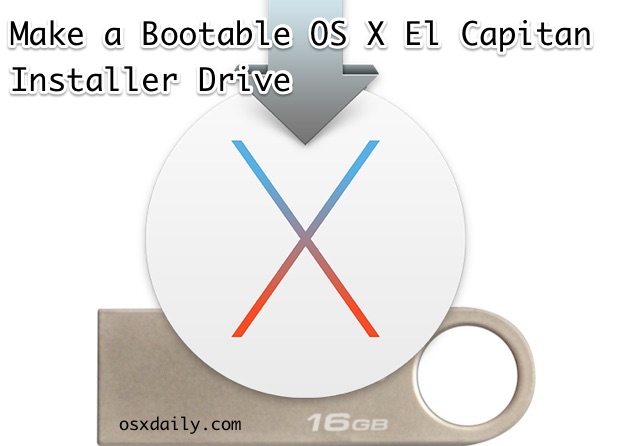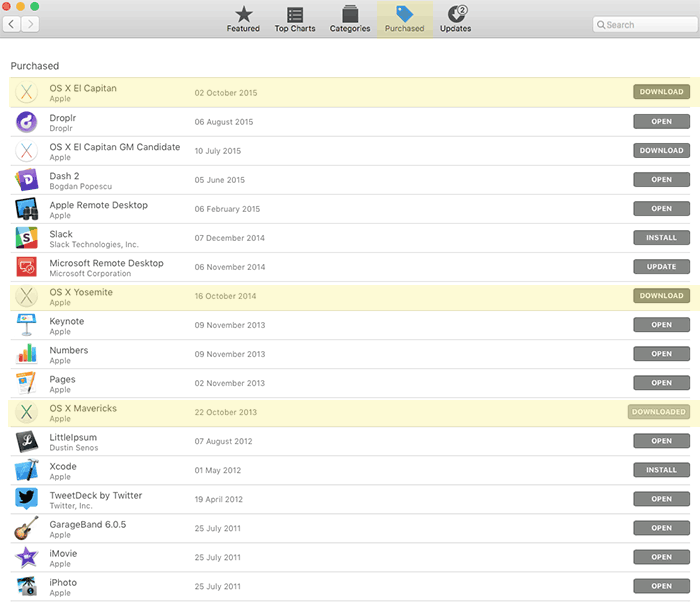- Os X El Capitan 10.11.0 Bootable Usb Dmg File Download
- Os X El Capitan 10.11.0 Bootable Usb Dmg File Windows 10
- Os X El Capitan 10.11.0 Bootable Usb Dmg File
Download OS X El Capitan 10.11.0 bootable USB (DMG File) (15A284) torrent or any other torrent from the Applications Mac. Direct download via magnet link. When you download OS X El Capitan using the Mac App Store, a raw package (.pkg) file is downloaded from the Apple server. MAC OSXElCapitan DMG by techrechard (MediaFire) The DMG file is around 5.67 GB, so you will need a good internet connection to download the macOS El Capitan DMG file. So, here is a tool that you can use to speed up the download process. Internet Download Manager tool that will help you enhance your downloading speed. To create a bootable Mac drive you need any disk with Mac OS X 10.11.0 El Capitan or newer (10.12 Sierra, 10.13 High Sierra, 10.14 Mojave, 10.15 Catalina) either running as your main system, or just being installed on a drive that's connected to your Mac at the moment.
OS X El Capitan 10.11.0 Bootable USB (DMG File) (15A284)
OS X El Capitan 10.11 | 5.7 GB

Use the 'Restore' option in Disk Utility to write it down on a USB-stick.
Enjoy!
How to do info.. (OS X Versions before El Capitan)
Format Your USB Flash Drive..
1. Insert the USB flash drive into your Mac’s USB port.
2. Launch Disk Utility, located at /Applications/Utilities/.
3. In the list of drives attached to your Mac, select the USB flash drive device. In my case, it’s called “16 GB TDK Stick”.
4. Click the ‘Partition’ tab.
5. Select ‘1 Partition’ from the Volume Scheme dropdown menu.
6. Enter a descriptive name for your flash drive; I chose 'OSXUSBInstall'
7. Select Mac OS X Extended (Journaled) from the Format dropdown menu.
8. Click the ‘Options’ button.
9. Select ‘GUID Partition Table’ from the list of available partition schemes.
10. Click ‘OK.
Now the USB flash drive is prepared you can Restore 'Install OS X El Capitan.dmg' to your USB flash drive.
1. Click on 'Restore' in the Disk Utility window.
2. Drag 'Install OS X El Capitan.dmg” to 'Source'
3. Drag the usb flash drive (in my case 'OSXUSBInstall') to 'Destination'
4. Click 'Restore' and enter your system password.
(To install OS X restart your Mac with “alt” hold and select your USB flash drive)
Done
How to do info.. (When El Capitan is already installed)
Format Your USB Flash Drive..
1. Insert the USB flash drive into your Mac’s USB port.
2. Launch Disk Utility, located at /Applications/Utilities/.
3. In the list of drives attached to your Mac, select the USB flash drive device. In my case, it’s called “16 GB TDK Stick”.
4. Click on “Erase”
5. Enter a descriptive name for your flash drive; I chose 'OSXUSBInstall'
6. Select Mac OS X Extended (Journaled) from the Format dropdown menu.
7. For Scheme choose “Guid Partition Map”
6. And click “Erase”
Now the USB flash drive is prepared you can Restore 'Install OS X El Capitan.dmg' to your USB flash drive.
1. Open Disk Utility
2. In the menu left of the “Disk Utility” window select the USB Drive. (The one you gave a specific name) In my case “OSXUSBInstall”
3. In the top menu bar from “Disk Utility” click “Edit” / “Restore”
4.Click on “Image” and go to the DMG File with El Capitan named “Install OS X El Capitan” and click “Open”
In the next window you see:
Restore from: Install OS X El Capitan.dmg
5. Now click “Restore”
It takes about 3 minutes to restore (In my case :-)
(To install OS X restart your Mac with “alt” hold and select your USB flash drive)
Done..
Are you trying to make a bootable installer? Do you have the El Capitan installer downloaded from the App Store? You cannot make a bootable DVD but you can make a bootable flash drive.


Bootable USB Installers for OS X Mavericks, Yosemite, El Capitan, and Sierra
First, review this introductory article: Create a bootable installer for macOS. Second, see this How To outline for creating a bootable El Capitan installer. Simply replace the Terminal command with the one from the preceding article by copying it into the Terminal window. You will need an 8GB or larger USB flash drive that has been partitioned and formatted for use with OS X.
Drive Partition and Format
- Open Disk Utility in the Utilities' folder.
- After Disk Utility loads select the drive (out-dented entry with the mfg.'s ID and size) from the side list.
- Click on the Erase tab in the Disk Utility toolbar. Name the drive, 'MyVolume'. <---- IMPORTANT!
- In the drop down panel set the partition scheme to GUID. Set the Format type to Mac OS Extended (Journaled.)
- Click on the Apply button and wait for the Done button to activate. When it does click on it.
- Quit Disk Utility.
Create Installer
Open the Terminal in the Utilities' folder. Choose the appropriate command line (in red) depending upon what OS X installer you want. Paste that entire command line from below at the Terminal's prompt:

Os X El Capitan 10.11.0 Bootable Usb Dmg File Download
Command for macOS High Sierra:
sudo /Applications/Install macOS High Sierra.app/Contents/Resources/createinstallmedia --volume /Volumes/MyVolume --applicationpath /Applications/Install macOS High Sierra.app
Command for macOS Sierra:
sudo /Applications/Install macOS Sierra.app/Contents/Resources/createinstallmedia --volume /Volumes/MyVolume --applicationpath /Applications/Install macOS Sierra.app
Command for El Capitan:

sudo /Applications/Install OS X El Capitan.app/Contents/Resources/createinstallmedia --volume /Volumes/MyVolume --applicationpath /Applications/Install OS X El Capitan.app
Command for Yosemite:
Os X El Capitan 10.11.0 Bootable Usb Dmg File Windows 10
sudo /Applications/Install OS X Yosemite.app/Contents/Resources/createinstallmedia --volume /Volumes/MyVolume --applicationpath /Applications/Install OS X Yosemite.app
Command for Mavericks:
sudo /Applications/Install OS X Mavericks.app/Contents/Resources/createinstallmedia --volume /Volumes/MyVolume --applicationpath /Applications/Install OS X Mavericks.app
Os X El Capitan 10.11.0 Bootable Usb Dmg File
Press RETURN. You will be asked for your admin password. It will not echo to the Terminal window. Then press RETURN again. Wait for the return of the Terminal prompt signifying the process has completed. It takes quite some time to finish. Be patient.
Mar 3, 2018 7:47 PM